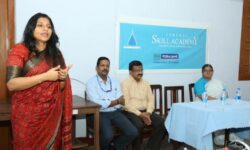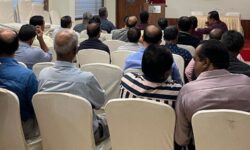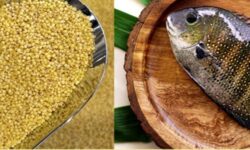KOCHI:
Interested in life drawing, but don’t yet have the skills? The Kochi Biennale Foundation (KBF) is hosting a three-day workshop on ways to sketch the human form using any medium of one’s choice.
At the Cabral Yard venue of the Kochi-Muziris Biennale (KMB), children participating in the February 13-15 drill are engrossed in human anatomy, trying to capture on canvas the features of a life model sitting before them.
Artist P S Jalaja is conducting a course that gives training on the doing images of women and men in various shapes and postures. Titled ‘Life & Line’, the workshop aims to teach the students on ways to pay stronger attention to drawing techniques on proportion, gestures, expression and tonal quality.
Jalaja, who was an artist in the inaugural edition of the KMB in 2012, says the current workshop is designed for everyone interested in the human figure and is looking for a strong foundation in drawing it.
Initially on Wednesday, at the art room, the students were guided to draw prominent human features such as eyes, noses and lips by looking at the model. She went on to explain where they faltered and the ways to rectify the mistakes. “Basically, the exercise is on what all one should keep in mind while working on a life drawing,” shares Kochi-based Jalaja, a member of the artist collective Kala Kakashi that uses art as a medium to support of public struggle for existence.
At the very start of the workshop, the artist instructed children not to use erasers. “If you use the eraser, you won’t understand where you have gone wrong,” points out the 35-year-old, who did her Masters from RLV College of Fine Arts, Tripunithura, south of this city. “You should, instead, draw the same thing a second or third time to understand the earlier mistakes and thus keep bettering one’s skills.”
“This is a very interactive workshop,” says Fathima Nazi, a class 8 student from Our Lady’s Girls High School in nearby Thoppumpady. “There is good focus on the essentials of realistic painting from life and learning to keep one’s brushwork expressive.”
Chipping in, Fathima’s friend Kalyani V Menon says the workshop was helping her learn the basics of drawings and the importance of lines.
Jalaja aims to make her students understand the basic procedure to represent the human body accurately from the anatomical point of view as well. “The first day was about the proportions and volumes. The second day will focus on gesture, which is the key to successful drawing,” adds the artist, who got one of the art room volunteer to be the life model for the kids.
The workshop began with discussion and demonstration of still life drawing and painting strategies. This will be a forenoon drill the workshop will follow till its conclusion.
Ann Benny, 13, who happened to visit the Biennale with family on Wednesday and strayed into the art room, plans to attend the workshop for the next two days. “Life drawings are generally taught in art colleges; here we are getting an opportunity to learn it at an early age,” she says. “I am not going to miss it.”
Jalaja notes that the KBF’s art room has been building a community of future artists and art-lovers, who have come together to both learn and appreciate drawings, paintings, sculptures and installations. “No other biennale in the world has this kind of a concept that aims to groom young talents alongside the festival. The art room is helping in the building of a community support group,” she adds.
A native of Keezhillam near Perumbavur in Ernakulam district, Jalaja’s works show deep concern for social and political matters even as they make sensitive artistic responses using local school of thoughts. From childhood, she has been fascinated by people and their mannerisms, leading her to watch them closely.
The crowd as an organic entity forms the backbone of Jalaja’s repertoire. Some of her canvases have thousands of people in them. “Each person in a crowd has a different expression, mannerism, skin colour…yet beyond all that, they are all humans primarily,” she adds.




